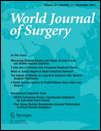Novel Prediction Score Including Pre- and Intraoperative Parameters Best Predicts Acute Kidney Injury after Liver Surgery
Milo A. Puhan and Pierre-Alain Clavien contributed as senior authors.
Electronic supplementary material: The online version of this article (doi:10.1007/s00268-013-2159-6) contains supplementary material, which is available to authorized users.
Abstract
Background
A recently published score predicts the occurrence of acute kidney injury (AKI) after liver resection based on preoperative parameters (chronic renal failure, cardiovascular disease, diabetes, and alanine-aminotransferase levels). By inclusion of additional intraoperative parameters we aimed to develop a new prediction model.
Methods
A series of 549 consecutive patients were enrolled. The preoperative score and intraoperative parameters (blood transfusion, hepaticojejunostomy, oliguria, cirrhosis, diuretics, colloids, and catecholamine) were included in a multivariate logistic regression model. We added the strongest predictors that improved prediction of AKI compared to the existing score. An internal validation by fivefold cross validation was performed, followed by a decision curve analysis to evaluate unnecessary special care unit admissions.
Results
Blood transfusions, hepaticojejunostomy, and oliguria were the strongest intraoperative predictors of AKI after liver resection. The new score ranges from 0 to 64 points predicting postoperative AKI with a probability of 3.5–95 %. Calibration was good in both models (15 % predicted risk vs. 15 % observed risk). The fivefold cross-validation indicated good accuracy of the new model (AUC 0.79 (95 % CI 0.73–0.84)). Discrimination was substantially higher in the new model (AUCnew 0.81 (95 % CI 0.76–0.86) versus AUCpreoperative 0.60 (95 % CI 0.52–0.69), p < 0.001). The new score could reduce up to 84 unnecessary special care unit admissions per 100 patients depending on the decision threshold.
Conclusions
By combining three intraoperative parameters with the existing preoperative risk score, a new prediction model was developed that more accurately predicts postoperative AKI. It may reduce unnecessary admissions to the special care unit and support management of patients at higher risk.




